Key takeaways:
- Selective mutism is a complex anxiety disorder often mistaken for shyness, requiring understanding and patience for effective communication.
- Creating a safe environment and promoting gradual exposure can encourage those with selective mutism to express themselves without fear.
- Support systems, including family, peers, and mentors, play a vital role in building confidence and facilitating communication for individuals struggling with selective mutism.
- Celebrating small victories and using creative outlets can help transform isolation into inclusion, allowing for various forms of expression.
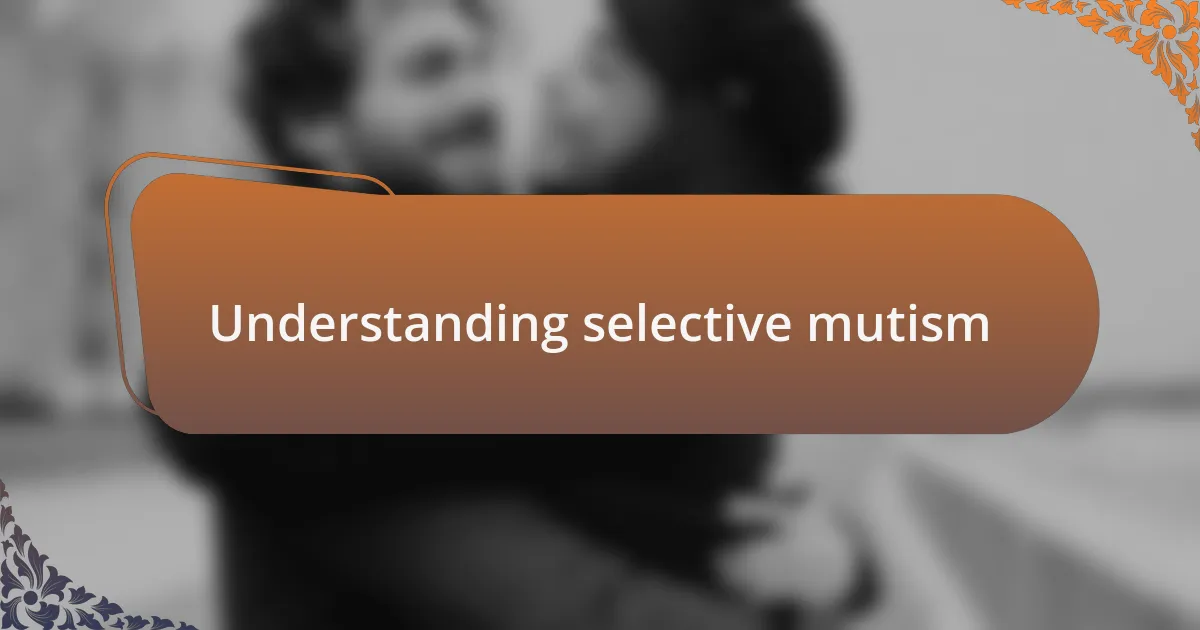
Understanding selective mutism
Selective mutism is not just a refusal to speak; it’s a complex anxiety disorder that can leave individuals feeling trapped in silence. I remember a friend from my childhood who would only whisper to her family while remaining mute around peers. This left me wondering, why is it that some voices are silenced by fear while others flow freely?
Often misunderstood as shyness, selective mutism can arise from various factors, including genetics and environmental influences. When I think about the pressures children face, I realize how overwhelming it can be for them to navigate social situations while grappling with this disorder. Can you imagine standing in a room full of people, desperate to communicate but feeling as if the words are stuck in your throat?
For many, the experience of selective mutism can be isolating. I once met an individual who described their days as a silent movie, where they could observe but not participate. It made me reflect on the profound impact communication has on our ability to connect with others. How do we break that silence and create a space where every voice matters?
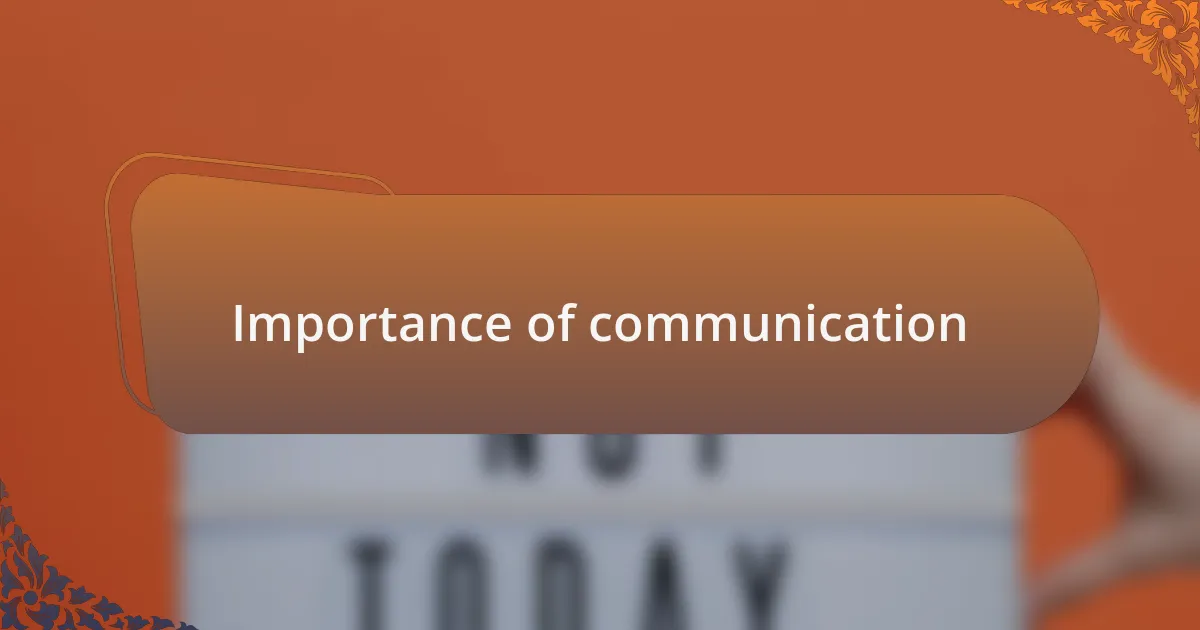
Importance of communication
Communication is a lifeline that connects us to the world around us. I recall a moment during a community event when I noticed a child with selective mutism watching eagerly from the sidelines, wanting to join in but unable to express their thoughts. It struck me how essential it is for everyone, especially those who struggle with speaking, to feel heard and understood. What if we could create environments where these individuals felt safe to communicate freely?
When I reflect on my own experiences, I realize that every conversation is an opportunity to share feelings and build relationships. I can’t help but think of times when I felt disconnected, simply because I couldn’t articulate my thoughts. In a world where words can bridge gaps, the importance of facilitating communication for individuals with selective mutism becomes even clearer. How can we foster this understanding and empower those silenced by anxiety?
There’s a unique magic in communication; it can transform isolation into inclusion. I once volunteered at a school where a child with selective mutism gradually started to communicate through drawings and gestures. Witnessing this transition was incredibly moving, as it demonstrated that communication takes many forms. Can we appreciate the beauty in all these modes of expression, and promote platforms for every voice to shine?
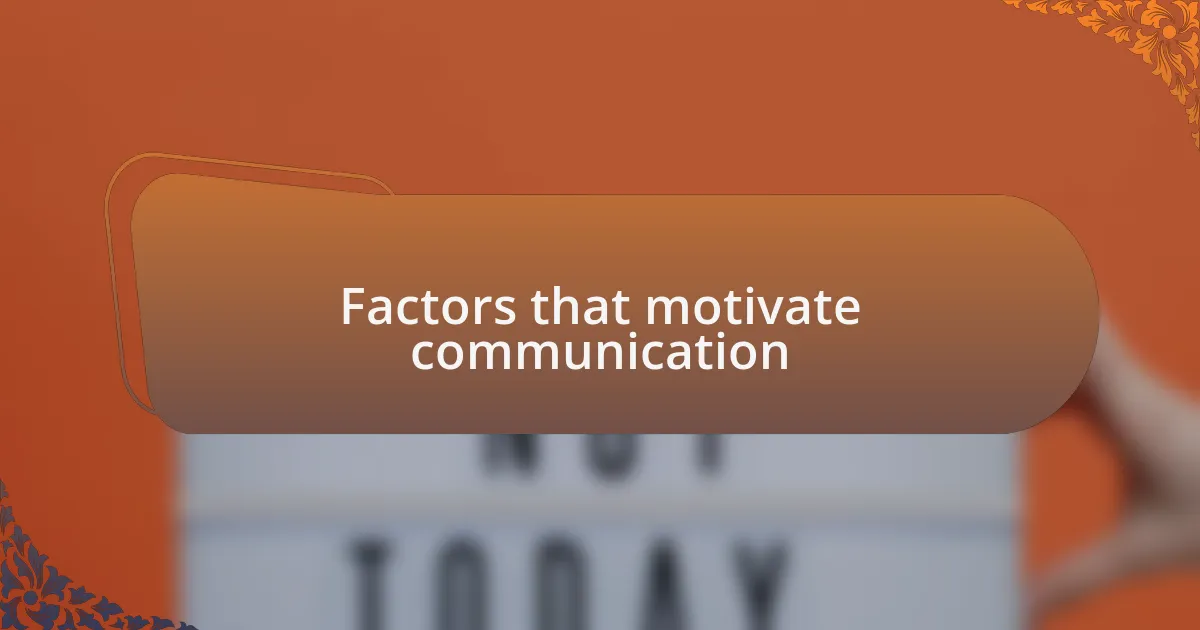
Factors that motivate communication
One of the strongest motivators for communication is the need for connection. I remember working with a young girl who struggled to speak in social settings but would light up when I engaged her in art activities. It was as if the colors and shapes became her voice, and I realized that when someone feels a sense of belonging, they’re more likely to express themselves. How can we create spaces that promote such connections, allowing those who find verbal communication challenging to engage without fear?
Another factor is the role of encouragement from peers and caregivers. I’ve seen firsthand how a gentle nod of approval or a warm smile can embolden someone to speak. It reminds me of a workshop I facilitated, where we celebrated small victories—each whispered word or shared thought was met with applause. Isn’t it fascinating to witness how positivity can unlock potential and invite individuals to break their silence?
Ultimately, understanding the underlying fears associated with selective mutism is crucial to motivating communication. I recall helping a student who was paralyzed by anxiety; when we practiced breathing exercises together, their confidence blossomed. It made me ponder—what if addressing those fears directly could open doors? By creating supportive environments, we can help transform apprehension into expression, inviting everyone to join the conversation.

Personal experiences with selective mutism
Personal experiences with selective mutism often reveal the profound impact of understanding and patience. I remember a moment with a child who rarely spoke in class but would eagerly share stories in one-on-one settings. It struck me how the right environment could coax out her voice, demonstrating that sometimes, all it takes is a little space to breathe.
In another instance, I worked with a teenager who struggled to express herself in group discussions. After months of consistent, gentle encouragement, she found the courage to share her thoughts in front of her peers. Witnessing her transformation made me realize the importance of not just listening but truly seeing the individual beyond their silence. What is it about genuine connection that fosters such bravery?
Navigating relationships with those who have selective mutism can be a delicate dance. I once interacted with a young boy who would often withdraw into himself when confronted by unfamiliar faces. I discovered that sharing my own childhood fears helped bridge the gap, allowing him to relate. It was a reminder that vulnerability can foster openness, transforming silence into a symphony of shared experiences.
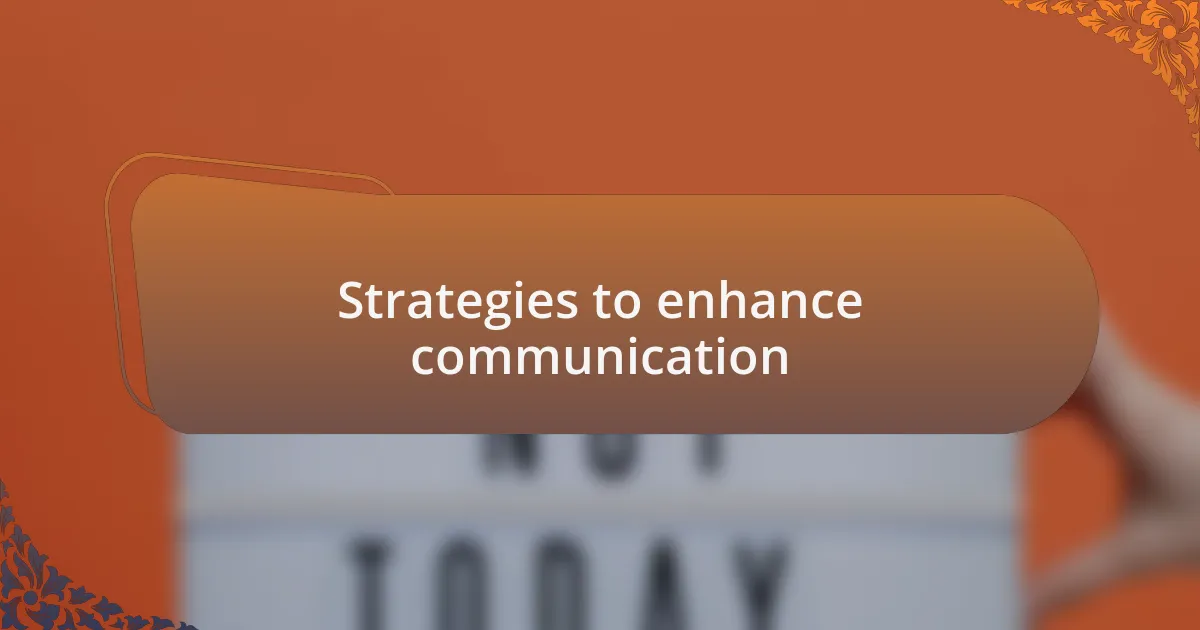
Strategies to enhance communication
One effective strategy to enhance communication for individuals with selective mutism is to create a safe and relaxed atmosphere. I remember a workshop where I introduced a series of creative art activities to encourage expression without the pressure of speaking. The kids were able to freely communicate through their artwork, and it was incredible to see how they opened up about their feelings without the weight of verbal expectations. What if we could all communicate in our own unique ways?
Another approach is the use of gradual exposure to stimulate communication. I once worked with a shy child who felt overwhelmed in large groups. By introducing her to a smaller circle of trusted friends and slowly increasing her engagement, I witnessed her growing comfort over time. It’s fascinating to think that each small step can lead to significant breakthroughs—how many other hidden voices are waiting to be heard?
Lastly, utilizing technology can also support those with selective mutism. I recall introducing a young girl to an app that allowed her to express her thoughts through writing and drawing. The joy on her face as she communicated in a way that felt safe to her was truly heartwarming. How can we leverage modern tools to create inclusive environments that empower everyone to share their voice?
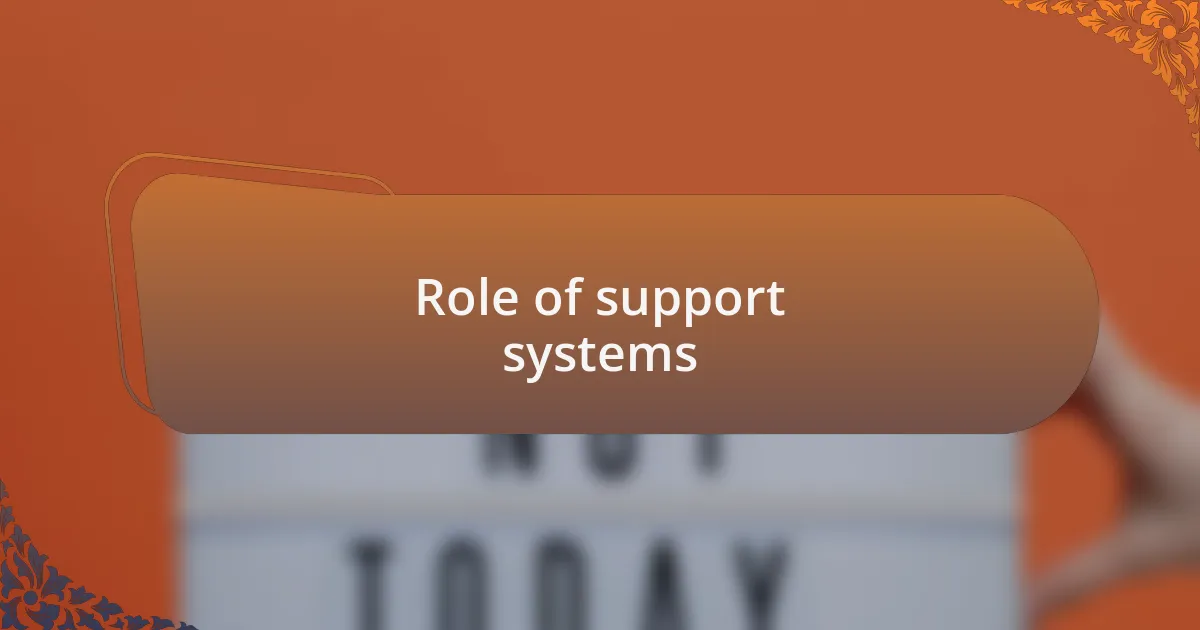
Role of support systems
Support systems play a crucial role in the journey towards effective communication for individuals with selective mutism. I recall a close friend who struggled for years with speaking in social situations. When her family and teachers collaborated to create a network of support, her confidence grew remarkably. Which is more powerful: the inner strength one discovers or the encouragement of those around us?
The impact of understanding and patient mentors cannot be understated. I once volunteered alongside a skilled speech therapist who dedicated time to listen actively to a child struggling to express herself. By validating her feelings and showing unconditional support, the therapist helped her find her voice at her own pace. Isn’t it fascinating how a single empathetic interaction can change everything?
Moreover, peer support can be transformative. In a small group setting, I witnessed a shy boy flourish when he connected with others sharing similar experiences. They encouraged each other to step outside their comfort zones, creating an atmosphere of acceptance and growth. Don’t we all thrive just a little more when we feel understood and included?
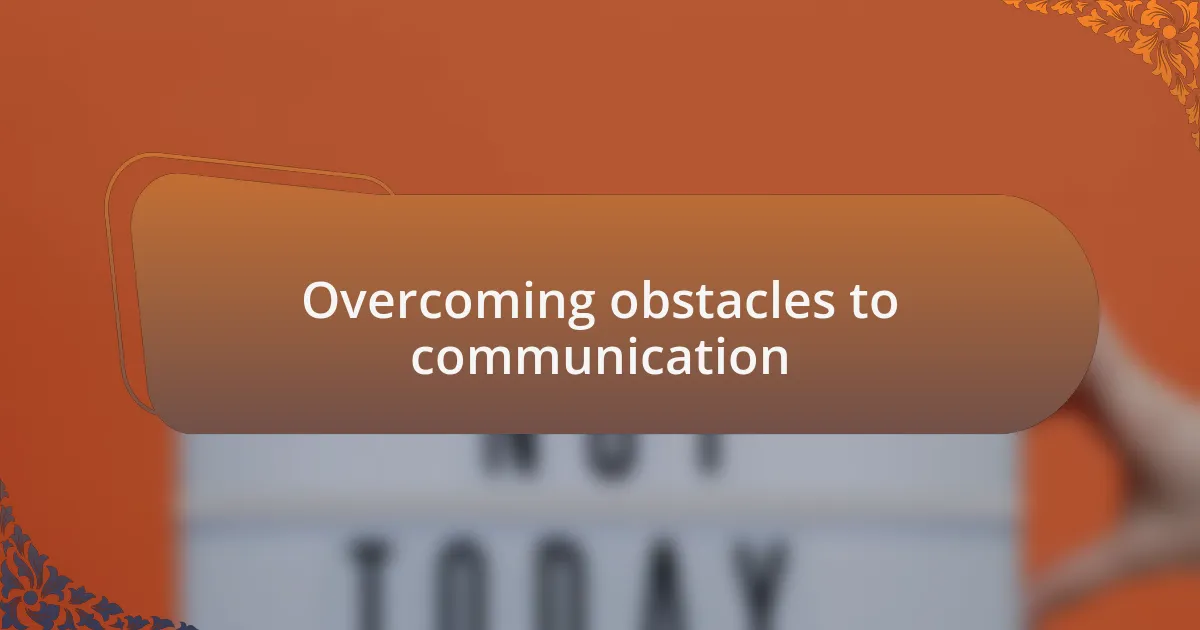
Overcoming obstacles to communication
Overcoming obstacles to communication often involves confronting deep-seated fears. I remember a time when I organized a small gathering for friends, hoping to provide a comforting space for anyone struggling with speech anxiety. One participant, virtually silent at first, slowly began sharing her thoughts once she felt the warmth of the group’s acceptance. Isn’t it intriguing how a supportive environment can shatter barriers that seem insurmountable?
Practicing gradual exposure can be a game-changer. I once encouraged a young girl, who rarely spoke in public, to voice her opinions through art. As she painted, we would discuss her choices, allowing her to express herself without the pressure of verbal communication. The joy I saw when she eventually spoke up about her work was a powerful reminder of how creative outlets can pave the way to verbal expression. Can you imagine the sense of liberation that comes from finding your unique mode of communication?
Additionally, celebrating small wins is crucial in this journey. I fondly recall attending a workshop where individuals shared their stories incrementally, building on each other’s successes. Each time someone spoke, no matter how briefly, the room would light up with support and applause. This shared joy reinforced the idea that every step, no matter how small, is a vital part of overcoming communication barriers. Have you ever felt that surge of pride after achieving something you once thought impossible?